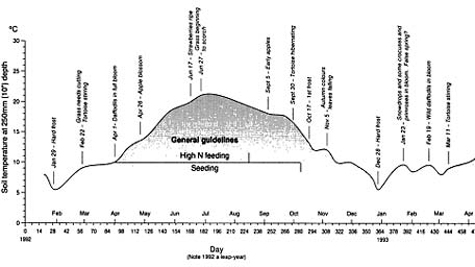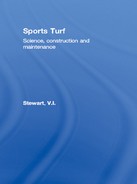Recording soil temperature
G.1
Procedure
Chose a maintained grass site that is level, freely drained, unshaded and with the soil unobstructed by stones or severe induration to a depth of 300 mm (12 in). Purchase from an ironmonger or garden centre a 300 mm (12 in) long, metal-sheathed soil thermometer and make up, or purchase, a 12 mm (1/2 in) wide, 300 mm (12 in) long, strong metal probe fitted with a handle—an old fashioned, long chisel is ideal. The probe is required to create the hole into which the thermometer is to be neatly inserted to 250 mm (10 in) depth without risk of damage, the idea being to enable close contact to be maintained between the metal sheath and the soil.
Measure soil temperature at 250 mm (10 in) depth weekly (or twice monthly), between midday and late afternoon, leaving the thermo

FIGURE G.1 Graph of 1992 soil temperature records as listed in Table A7.1.
TABLE G.1 1992–93 soil temperature records at 250 mm (10 in) depth beneath garden lawn near Aberystywth. Grass maintained during growing season by weekly mowing at not less than 25 mm (1 in); clippings mostly returned. Soil a freely drained, clay loam with earthworms present, therefore no surface mat
meter in place to equilibrate for a period of about 5 min. Record in a diary, along with notes about weather conditions, vegetation and other related observations, and enter as an additional plot on a continuously recorded, one-year graph. (Refer to Figure G.1 and associated observation records in Table G.1.)
Interest will develop as data accumulates to enable comparisons to be made, one year with another, and ideas about local norms and seasonal trends developed. This local knowledge will help to interpret variations in sward performance from one site to another and one year to the next, and will assist in the timing of management procedures such as fertilizing and seeding where the response is likely to be temperature dependent.
G.2
Aids to interpretation
- The site to which the data in Figure G. 1 refers is an unshaded garden lawn at 15 m (50 ft) above sea level, on the north side of a broad, east-west valley, 1 1/2 km (1 mile) inland from the coast of mid-Wales, just north of Aberystwyth.
- The soil temperature at 250 mm (10 in) tends to vary between a winter low of about 5° C and a summer high of about 20°C, with values of 9°C and above likely to promote growth, all other conditions being favourable. On this basis, the 1992 growing season began mid-March and continued until late November.
- The soil temperature tends to rise at an average rate of 0.75°C per week through spring and into summer, falling again at a similar, or slightly slower rate, through autumn into winter. At these transition periods, however, a spell of low air temperatures will affect the surface of the soil and limit germination from seed and seedling growth.
- Think of soil temperature, at or below 250 mm (10 in) depth, as reflecting the heat store available to warm the soil from below. However, once the soil surface becomes frozen the effect will reduce the influence of this heat store at least temporarily, but because it is maintained geothermally from below, the 250 mm (10 in) depth value will readily recover to its more normal winter range of 6–8°C, just enough to maintain a very slow rate of grass growth.
- There is no point in applying highly soluble, readily leached fertilzers before soil temperature is adequate to enhance growth. Therefore, delay application of seed and nitrogen-rich fertilizer, until the spring surge of soil temperatures exceeds 9–10°C. In the autumn the fall in soil temperatures will lag behind the fall in air temperatures and this will affect the performance of seeds and seedlings at the surface. It is advisable, therefore, to avoid seeding in the autumn beyond the point at which soil temperature at 250 mm (10 in) falls below 14 or 15°C.
